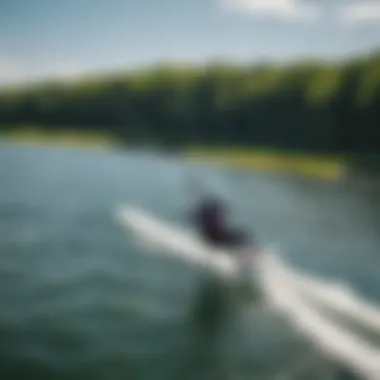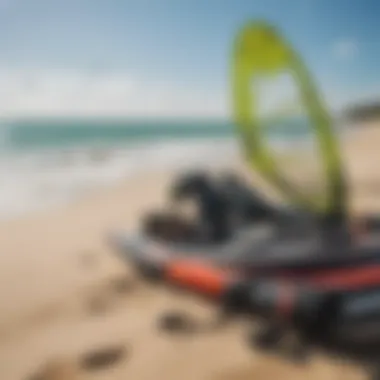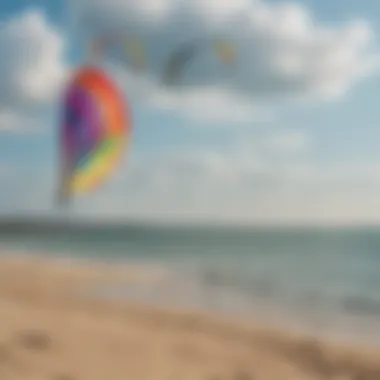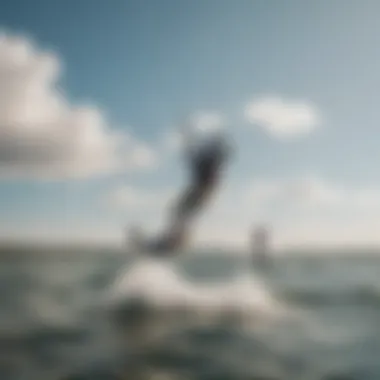Kiteboarding in Michigan: A Deep Dive into the Scene


Intro
Kiteboarding in Michigan is more than just a sport; it’s a way of life for many who take to its vibrant waters. With the long stretches of shoreline along the Great Lakes, the winds that rush in are a kiteboarder's dream. This article is set to unravel the layers of kiteboarding within the state, showcasing not only the thrilling experience it offers but also the rich community backing this exciting pastime. Whether you're a novice eager to untangle the complexities of kiteboarding or a seasoned rider searching for the hidden gems in Michigan’s landscapes, there’s something here for everyone.
From gear selection to skill development, this guide strives to equip readers with practical knowledge and personal insights that elevate their kiteboarding experience in Michigan. Each section is crafted to ensure a thorough understanding and appreciation for the state’s unique topography and culture surrounding this exhilarating sport.
Gear Selection
Picking the right gear for kiteboarding in Michigan plays a crucial role in enjoying the sport without a hitch. Given the diverse weather conditions and beach environments, understanding the specific requirements can make or break your experience.
Types of Kites
The market is swarming with a variety of kites available, each with its own advantages. Most kiteboarders find themselves debating between a few key types:
- C-kites: Known for their performance in the waves, these kites excel for advanced tricks and jumping.
- Bow kites: Easy to handle and with excellent depower capabilities, they are ideal for beginners.
- Delta kites: These kites incorporate features from both C-kites and Bow kites, providing a balance of power and stability.
Choosing the right kite will often depend on your personal style and the conditions of the day. On calmer days, a larger kite might increase the fun factor, while, on gusty days, it’s wise to opt for a smaller option to maintain control.
Choosing the Right Board
The board you select is almost as essential as the kite itself. In Michigan’s varied water conditions, consider the following types:
- Twin-tip boards: Most popular among kiteboarders, they allow for riding in either direction, giving flexibility in movement.
- Directional boards: Great for waves or downwind riding, these boards can only be used facing one way, perfect for those who favor that surf-style experience.
- Foil boards: A newer addition, these are gaining popularity due to their ability to glide over the water, allowing riders to catch even the smallest winds.
Take your time finding a board that not only fits your skill level but also the style you intend to pursue.
Skill Development
Once you've got your gear sorted, the next step is to hone your skills. Kiteboarding is dynamic and often requires good technique and adaptability.
Essential Techniques
Key techniques are paramount for safety and enjoyment. Some of these include:
- Body dragging: Essential to mastering control over your kite while in the water—this will help you retrieve your board in case you lose it.
- Water relaunching: Learning how to get your kite back in the air after a fall is as critical as flying it.
- Controlled landings: This helps in minimizing the risk of injury and damage to your equipment when you come back down from a jump.
Progression Tips
Each kiteboarding session presents a new opportunity to improve.
- Practice regularly: Consistency helps you internalize new skills, making them second nature.
- Watch others: Observing experienced kiteboarders can provide inspiration and insight into techniques you may want to work on.
- Join the community: Engaging with others—whether through social media groups like those on Facebook or forums on Reddit—can offer invaluable tips and encouragement.
"The journey of kiteboarding is as exhilarating as the ride itself. Every gust of wind, every wave, is a learning experience that connects you deeper with nature, and with yourself."
As you embark on this thrilling adventure of kiteboarding in Michigan, remember to continuously refine your skills and connect with the community. With every session, the water is not just a place to ride, but a space for growth and camaraderie.
Prelude to Kiteboarding in Michigan
Kiteboarding has gained a solid footing in Michigan over the years, turning this Midwestern state into a hub for adventure seekers and water sport enthusiasts. This article serves as a guide to understanding the nuances of kiteboarding specific to Michigan, touching on everything from geographical advantages to community culture. The unique interplay of lakes, wind patterns, and the vibrant local scene makes this sport an intriguing subject for both newcomers and seasoned riders.
Understanding the Sport
Kiteboarding is more than just a thrilling ride across the water; it's a unique blend of surfing, snowboarding, and paragliding. Riders harness the power of the wind using a large kite to propel themselves on a board over the waves. The result is an exhilarating experience that can be tailored to various skill levels, from leisurely cruising to adrenaline-pumping tricks.
Understanding the basics involves knowing how the equipment works, learning to control the kite, and mastering the board. Local shops and instructors offer classes that can help beginners get their feet wet in the sport. For those who already have experience, kiteboarding is a chance to push their limits and refine their techniques.
Michigan's Kiteboarding Landscape
Michigan's landscape is a treasure trove for kiteboarding, featuring numerous lakes and a sprawling coastline that provide various riding conditions. The state is bordered by four of the Great Lakes, offering some of the largest bodies of fresh water in the world. This abundance allows for varied experiences, from flat waters ideal for beginners to more challenging, choppy waters for advanced riders.
When talking about the kiteboarding culture here, it's not just about the spots but also the camaraderie. Many riders are more than happy to share tips, suggest some fun local sites, and even join you on the water. The sense of community is palpable, with events and competitions helping to foster a tight-knit atmosphere.
"Kiteboarding is not merely a sport; it cultivates a community that values adventure and shares a deep love for the water."
Geographic Considerations for Kiteboarding
When it comes to kiteboarding, geography plays a crucial role in determining where and how enthusiasts can engage with the sport. Michigan, with its extensive coastline and numerous inland lakes, offers a kaleidoscope of locations for riders at different skill levels. Understanding the geographical nuances helps kiteboarders optimize their experience, whether they are chasing the perfect wave or seeking reliable wind conditions.
Lakes and Coastlines
Michigan’s vast array of lakes—more than 11,000 of them—combined with its position as a Great Lakes state, makes it a prime spot for kiteboarding. Locations like Lake Michigan and Lake Huron provide diverse views and riding experiences.
When you think about spots like Traverse City or Holland, the picturesque coastlines not only entice with their natural beauty but provide consistent wind patterns that kiteboarders crave. That consistent breeze lends itself to smoother riding, allowing for both advanced maneuvers and leisurely sessions.
The following factors are key when selecting lakes or coastal sites:
- Water Depth: Shallow areas can be perfect for beginners, whereas deeper waters might be better suited for more experienced riders looking to perform complex tricks without risk of injury.
- Accessibility: Ease of access can vary between locations. Some spots boast amenities like parking and picnic areas, while others may be a trek across sand or rough terrain.
- Crowd Density: Popular lakes can get crowded, especially during peak summer months. A lesser-known spot can provide a more peaceful experience and more room to practice and hone skills.


Riders should keep an eye on local conditions, too. Michigan's lakes can experience sudden changes in weather, so checking forecasts online is always wise.
Wind Patterns and Conditions
Wind is the lifeblood of kiteboarding. The heart of Michigan's kiteboarding allure can largely be attributed to its varied wind patterns. With breezes blowing in from the Great Lakes, riders are often met with ideal wind conditions. However, the characteristics of wind can vary from season to season.
Some pivotal aspects to consider include:
- Seasonal Changes: Summer typically brings more stable winds, while spring and fall can be wildly unpredictable. Knowing how these shifts play out can greatly enhance your kiteboarding sessions.
- Local Knowledge: When you’re hitting the water, sometimes you gotta rely on the word on the street. Local kiteboarding communities often have invaluable insights on the best times and spots for prime wind conditions. This can lead to thrilling sessions you might miss otherwise.
- Wind Speed and Direction: A wind speed of 10-20 mph is often ideal, but preferences can vary based on skill level and kite size. Understanding how the wind interacts with local geography—like landforms or tree lines—will also help in selecting your ideal position.
"Wind is to kiteboarding what fuel is to fire; you can't have one without the other."
For more on Michigan's commanding winds and water conditions, check the local kiteboarding forums or groups on platforms like Reddit and Facebook.
Understanding the lay of the land isn’t just useful; it’s fundamental to enjoying what Michigan has to offer for kiteboarders.
Kiteboarding Destinations in Michigan
Kiteboarding is not just a sport; it’s an experience molded by the landscapes that it takes place in. Michigan, with its abundance of lakes and coastal lines, offers a variety of kiteboarding spots that cater to different skill levels and preferences. Having clear knowledge of your kiteboarding destinations can greatly affect your overall experience, adding thrill and enjoyment to your ride.
Popular Lake Locations
The Great Lakes are a kiteboarder’s dream. Among these, Lake Michigan stands out for its endless stretches of water, stunning beaches, and consistent wind.
- Northwest Michigan: This area is known for its reliable winds. Spots like Crystal Lake provide a sheltered environment when the winds are gusty.
- Lakeside Beach: Located near South Haven, it's a prime location for both beginners and experienced riders. The shallow waters allow for easy starts and help in practicing maneuvers.
- Houghton Lake: This giant inland lake is another favorite spot, primarily due to its spaciousness and steady winds, making it suitable for long rides.
Kiteboarding here is more relaxed compared to coastal spots. Riders can enjoy a family-friendly atmosphere alongside their kiteboarding adventures.
Best Coastal Sites
When it comes to coastal kiteboarding, Michigan offers more than just pristine views.
- Saugatuck Dunes State Park: The combination of sandy beaches and significant wind patterns makes it one of the best coastal locations. Here, you experience both stunning sunsets and exhilarating rides.
- Grand Haven: This vibrant coastal city regularly hosts kiteboarding events, making it not only a great location to ride but also an excellent place to catch up with fellow enthusiasts.
- Lake Erie Shores: The southeastern part of Michigan offers different wind conditions that can challenge even advanced riders. Spots along the shores enable the experience of both flat waters and rough waves.
Kiteboarding along the coast provides an added layer of excitement as the waves and wind create dynamic conditions that can enhance the skillset of any rider.
Hidden Gems
Beyond the well-known spots, Michigan is dotted with hidden gems that may appeal to those looking for a more secluded kiteboarding experience.
- Leelanau Peninsula: This lesser-known area offers tranquil waters and stunning scenery. With fewer crowds, it’s a perfect spot for those who prefer peace while riding.
- Crisman Lake: Tucked away from the bustling tourist spots, Crisman Lake provides calm waters ideal for beginners. Riders can practice their techniques without the pressure of other kites in the sky.
- Sand Point: Located near Lake Michigan, it’s somewhat off the beaten path. The site is known for its unique wind patterns that can change rapidly, providing skilled riders with a fun challenge.
These hidden gems highlight the diverse locations available for kiteboarding across Michigan, making it a treasure trove for adventurers. Each spot showcases the beauty of the state while offering a unique kiteboarding experience that enhances skill and enjoyment.
"Finding the right place can turn an ordinary kiteboarding day into an unforgettable adventure. Each corner of Michigan breathes unique charm and opportunity for every kiteboarder."
In summary, whether you're looking for popular spots with all the buzz or hidden gems away from the crowds, Michigan holds the promise of diverse kiteboarding destinations tailored to every need.
Equipment Essentials
In kiteboarding, the equipment you use can make or break your experience. Understanding the various types of gear available, along with their specific features and applications, is essential for anyone looking to enjoy this thrilling sport in Michigan's diverse landscapes. This section explores the core components of kiteboarding gear, focusing on specific elements that are vital to both novices and seasoned riders.
Types of Kites
The heart of kiteboarding lies in the kite itself. Kites come in several styles, suited for different wind conditions, rider levels, and surfaces you ride on. The most common types of kites include:
- Lease kites - Widely used for jumps and tricks. They have a high aspect ratio, providing excellent lift and are ideal for aggressive riding styles.
- C kites - characterized by their deep profile, are designed for power and speed, making them perfect for experienced kiteboarders who wish to perform advanced maneuvers.
- Bow kites - Offer maximum depower and are great for beginners. They provide stability and are versatile in varying wind conditions.
- Delta kites - Like a hybrid of C and bow kites, these are suitable for both learning and advanced riding. They feature unique shapes that allow for a wide wind range.
Choosing the right kite is crucial. If you pick the wrong type, you might struggle against the winds or miss the thrill of soaring high above the water. For Michigan's conditions, where strong gusts can be common, a bow or delta kite often comes recommended for its stability.
Boards and Accessories
Along with kites, the board you ride is just as critical. Kiteboards typically come in two main styles:
- Twin-tip boards - Most popular among kiteboarders, offering the ability to ride in both directions, making them user-friendly, especially for those starting out.
- Directional boards - are designed for specific riding styles, like surfboarding. They are beneficial in waves and allow for a different type of riding experience.
Accessories also play an important role. Essential items include:
- Harness - It distributes the load from the kite, allowing you to maintain a comfortable position while riding.
- Safety leash - A must for safety. It connects you to the kite and prevents it from drifting away into dangerous territory.
- Pump - Essential for inflating the kite quickly, so you're ready to hit the water.
Selecting the perfect board and accessories may feel overwhelming, but consider your style. If you enjoy speed with jumps, you might prefer a flexible twin-tip. If you’re more into carving the waves, then a directional board would better meet your needs.
Choosing the Right Gear
The process of selecting equipment goes beyond merely picking what's shiny and new. Factors such as your skill level, local weather conditions, and personal riding style should guide your decisions. When considering your setup, keep in mind the following:
- Weight and Size - Ensure that the kite size corresponds to your weight and riding level. A larger kite can be too cumbersome for beginners.
- Local Conditions - Michigan has varied wind patterns. Familiarize yourself with local spots and the typical conditions before choosing equipment.
- Budget - High-end gear can be tempting, but find gear that fits your pocket. There are plenty of options that don’t break the bank but still offer great performance.


Investing in knowledge about your equipment is as vital as the gear itself. Learning about maintenance, care, and proper storage extends the life of your equipment and enhances your performances on the water.
"The right gear is not just about thrills; it's about safety and experience. A well-prepared kiteboarder can enjoy more than just the ride."
Exploring kiteboarding in Michigan opens a door to a community that values safety alongside adventure. So gear up, stay educated, and keep your wits about you as you conquer the winds.
Safety Protocols and Best Practices
When it comes to kiteboarding in Michigan, understanding safety protocols and best practices can mean the difference between an enjoyable day on the water and a potential disaster. The dynamic nature of kiteboarding, with its unpredictable winds and varying conditions, requires not only skill but also a commitment to safety. The goal here is to ensure that every ride is fun and secure—so let’s dive into what that entails.
Pre-Ride Safety Checks
Just like you wouldn’t drive a car without checking the oil and tires, kiteboarding demands a thorough inspection of your gear before hopping onto the water. A pre-ride safety checklist should become second nature for any kiteboarder. Here’s what you should consider:
- Inspect Your Kite: Look for any signs of wear and tear, such as frayed lines or holes. A quick patch job can save you from a nasty tumble.
- Check the Lines: Tangled or damaged lines can cause control issues. Make sure they are untangled and everything looks robust.
- Board Condition: Ensure that your board is free of cracks or dings and that the foot straps are secure. Any looseness can compromise your stability.
- Harness Fit: Always check that your harness fits snugly. A loose harness can pose a serious risk if you have to perform an emergency release.
A quick inspection may only take a couple of minutes, but it can prevent hours of regret. An old saying goes, "An ounce of prevention is worth a pound of cure." This principle holds especially true in kiteboarding.
Emergency Procedures
Even with the best preparations, accidents can happen. Knowing what to do when things go awry is paramount for safety on the water. Familiarize yourself with these emergency procedures:
- Understanding the Winds: Always have a plan B in your back pocket. If the winds suddenly change, know where to go for shelter. Find a visible landmark that signifies safety.
- Dealing with Equipment Failure: If your kite loses its wind, remain calm. You may just need to relaunch or swim back to shore. Always try to stay with your equipment.
- Distressed Signals: Learn and use recognized hand signals for distress. A raised arm or waving hand can alert nearby kiteboarders or boaters to your situation.
- Know Your Helpers: Before getting started, identify who else is around you. Who are the seasoned veterans? They may have experience dealing with emergencies and can be helpful.
In the fast-paced world of kiteboarding, these emergency protocols are crucial. The idea is to minimize panic when every second counts. As kiteboarders, we must look out not just for ourselves but for one another. Remember,
"Safety is not a gadget but a state of mind."
Implementing these safety protocols and being aware of best practices can vastly improve your kiteboarding experiences in Michigan. Take the time to prepare, stay informed, and you'll be riding the winds with confidence.
Local Kiteboarding Community and Culture
The local kiteboarding community in Michigan represents a blend of enthusiastic individuals who share a passion for the sport and the region’s unique qualities. This culture is not just about the act of kiteboarding; it's about the connections made, the knowledge shared, and the camaraderie developed among kiteboarders of all skill levels. The community fosters an environment where newcomers can learn the ropes while seasoned veterans can explore their limits, making it an essential part of the kiteboarding experience in Michigan.
Events and Competitions
Events and competitions are a lifeblood for any sport, and Michigan's kiteboarding landscape is no exception. Throughout the year, various events are held that bring kiteboarders together to showcase their skills and share the thrill of the sport with others. These gatherings range from friendly competitions to more formalized contests that attract top talent from across the state and beyond.
A few notable events include:
- Michigan Kiteboarding Cup: This annual competition boasts a vibrant atmosphere filled with spectators and participants alike. Riders compete in various categories based on skill and style, providing an excellent opportunity for networking and exposure.
- Kiteboarding Festivals: Events like the Grand Haven Kite Festival not only highlight the sport but also introduce aesthetics through impressive kite displays. It's a colorful sight where kite enthusiasts from all walks of life come together to celebrate artistry and athleticism.
These events serve dual purposes: they offer competition and they cultivate community spirit. They help to break down barriers among riders, creating a welcoming environment for people to share stories and experiences, as well as tips and tricks.
Training and Instruction
One of the most critical components of any kiteboarding community is access to quality training and instruction. In Michigan, several local schools and experienced instructors offer lessons tailored to all levels, from absolute beginners to those looking to master specific tricks or techniques.
The training landscape includes:
- Beginner Courses: Designed for those who have never touched a kite, these lessons cover everything from safety protocols to fundamental skills. Instructors often emphasize a hands-on approach, ensuring students develop confidence quickly.
- Intermediate and Advanced Training: For those who’ve got the basics down, advanced clinics focus on refining skills and learning new maneuvers. This is where riders often discover their unique style and personal challenges.
- Community Workshops: Many local organizations occasionally host workshops. These delve into specialized topics like gear maintenance, adverse weather strategies, and injury prevention, enriching the riders' knowledge base.
Having a robust training infrastructure ensures that the kiteboarding community continues to grow, as well-trained individuals inspire others. Local instructors often double as mentors, forming lasting relationships that extend beyond mere lessons.
The kiteboarding community in Michigan is a gem, offering an inviting atmosphere for new and seasoned riders to connect and grow.
In lagging the right balance of thrill, safety, and fun, the kiteboarding culture in the Great Lakes state thrives, promising an enduring legacy for generations to come.
Environmental Considerations
Kiteboarding's fun and thrills intertwine with nature, rendering it essential to address the environmental considerations tied to the sport. Understanding how kiteboarding impacts local habitats and the beauty of Michigan's landscapes can help create a balance between adventure and conservation. Within this realm, kiteboarders must remember the responsibility they carry toward preserving the environment for generations of riders to come. This section dives into sustainable practices for kiteboarding in Michigan and ways to protect the delicate ecosystems where these thrilling activities take place.
Sustainable Practices
Adopting sustainable practices while kiteboarding not only enhances the experience but also ensures the sport remains viable over time. Here are some key sustainable measures to consider:
- Respect Natural Spaces: Always stay within designated kiteboarding zones to minimize impact
- Leave No Trace: Remove all personal belongings and trash. The shore is not a trash can; keep it clean for others.
- Eco-Friendly Gear: Choose equipment made from sustainable materials when possible. Brands are increasingly offering eco-conscious choices.
- Educate Fellow Riders: Share information about sustainability with others. Awareness can ripple through the kiteboarding community.
Incorporating these habits can foster a culture where nature is cherished, not merely utilized.
Protecting Local Ecosystems
The natural environments where kiteboarding happens often host diverse flora and fauna, which can be disturbed by human activities. Being proactive about protecting local ecosystems is crucial. Here are some considerations:
- Observe Wildlife: Keep an eye out for nesting birds or other wildlife. Avoid areas where animals are breeding or feeding, as disturbances can be detrimental.
- Water Quality: Understand what entities, like pollution and waste, might harm water quality. Programs like shoreline clean-ups can play a part in ensuring waters stay healthy.
- Collaborate with Local Organizations: Get involved with groups dedicated to protecting local ecosystems or participate in conservation projects.
Protecting our ecosystems isn’t just a nice thing to do; it’s a necessity for our sport’s future. A well-maintained environment ensures kiteboarding remains a joy for everyone.


As kiteboarding continues to gain momentum in Michigan, fostering a culture of sustainability will prove key in preserving the breathtaking landscapes that make this sport so enjoyable. Emphasizing responsibility can make the kiteboarding community an ally in nature's conservation efforts.
Skill Advancement and Technique
Kiteboarding, much like any other sport, requires a smooth progression in skills. Whether you're just dipping your toes in the water or already catching waves, honing your techniques can elevate your experience immensely. In Michigan, where the kiteboarding community thrives, gaining proficiency is not merely about tricks—it's about understanding the wind, water, and your own capabilities. Skill advancement can lead to confidence, safety, and ultimately a more fulfilling ride, enriching your connection to this exhilarating sport.
Fundamentals for Beginners
For those new to kiteboarding, the fundamentals groundwork lays the path for further development. It's all about mastering the basics. Here, you will learn vital control over your kite, balance on the board, and body positioning—all essential elements in enjoying your first rides while staying safe.
Starting with kite control is crucial. Spend time on the beach practicing with a trainer kite, getting a feel for the pull and understanding how wind direction affects your flight path. A good rule of thumb is to always keep your kite low during initial attempts. This will lessen potential crashes, allowing for a smoother introduction.
Additionally, learning to ride upwind is paramount. This will enable you to return to your starting point. Practicing with a buddy or enrolling in a local kiteboarding school can provide valuable feedback and support.
"Every expert was once a beginner. Don’t rush the process; every minute on the water counts!"
Progressing to Intermediate Skills
Once the fundamentals are in place, it's time to level up. As an intermediate rider, you’ll start to embellish your technique with more advanced movements and control. The goal is to make your riding smooth and responsive.
Begin focusing on your edging and stance. Proper edging allows you to harness the power of the wind while maintaining stability on the board. Consider attempting transitions from heel to toe side and back again; this skill will enhance your directional changes and give you greater versatility in various conditions.
Incorporating controlled jumps into your repertoire is also key. Understanding how to pop off the water and land softly can be both thrilling and empowering. Focus on your timing with the kite's pull and the board's lift. Start small, and as you gain confidence, increase the height of your jumps and the complexity of your landings.
Advanced Maneuvers and Tricks
Reaching advanced levels opens the door to creativity on the water. Maneuvers like spins, grabs, and even unhooked tricks become attainable with skill and practice. These levels require a strong foundation in balance and kite control, so ensure you are fully comfortable with intermediate skills.
Analyze your favorite kiteboarders and study how they maneuver. Try break down advanced tricks step by step; it helps to visualize yourself performing maneuvers in the water before attempting.
Furthermore, flow is essential at this stage. It’s not just about executing tricks but doing so with style and fluidity. The more you practice, the more these skills will become second nature. Remember, patience is key; progression takes time, so don’t be disheartened by setbacks.
End
In kiteboarding, skill advancement is not just an enhancement of techniques—it's a journey that intertwines with the joy of riding. Whether you're riding on the pristine lakes of Michigan or enjoying coastal breezes, understanding and advancing your skills can significantly amplify your kiteboarding experience. Every effort put into practice shapes you into a seasoned kiteboarder, ready to tackle challenges with ease and grace.
Regulations and Local Laws
Understanding the regulatory framework surrounding kiteboarding in Michigan is essential for safety, compliance, and maximizing the enjoyment of this exhilarating sport. Kiteboarding is subject to both state and local laws that can dictate when, where, and how enthusiasts can ride the waves. As participants in this dynamic outdoor activity, kiteboarders must be well-informed about various regulations to prevent mishaps and ensure a harmonious experience with the environment and fellow water users.
Understanding State Laws
In Michigan, the Department of Natural Resources has laid down specific laws governing water sports, including kiteboarding. These laws aim to protect both the participants and the ecosystems in which they operate. For instance, kiteboarders must understand the stipulations regarding public waterway usage versus private property. Certain lakes may have restricted areas, while others could be open for recreational activities like kiteboarding.
Some key considerations include:
- Water Safety: Michigan requires that all watercraft users maintain a safe distance from swimming areas, docks, and other vessels.
- Age Restrictions: There are minimum age requirements for operating kiteboarding equipment; younger individuals may need adult supervision.
- Equipment Standards: All kiteboarding gear must meet industry safety standards, which includes having safety handles, quick-release mechanisms, and harnesses that are properly fitted.
Moreover, it's crucial to stay updated on any changes in state laws, as guidelines may evolve due to environmental concerns or user feedback. Following regulations not only enhances one’s safety but also contributes to preserving the beautiful landscapes Michigans has to offer.
Permitting and Usage
While many areas in Michigan are open for kiteboarding, some locations may require permits. Typically, these permits are aimed at organizing events, competitions, or large gatherings of kiteboarders that could impact local communities. For example, sites like Lake Michigan attract numerous enthusiasts during peak season, which can lead to conflicts over space.
A few things kiteboarders should keep in mind include:
- Research Local Ordinances: Check with local municipalities about required permits in each kiteboarding destination. Some parks may request a permit for specific activities to facilitate better management of natural resources.
- Organized Events: If participating in a race or a public gathering, ensure that permits are obtained in advance—often the event organizers handle this aspect.
- Respect Designated Areas: Adhering to designated zones marked for kiteboarding prevents restrictions and fines while promoting safer practices for all water users.
"Being aware of and adhering to local regulations helps ensure a safe and enjoyable kiteboarding experience while protecting our valuable waterway resources."
Navigating the local laws surrounding kiteboarding not only enriches the experience but also fosters a sense of responsible community participation in Michigan's kiteboarding culture. By taking the time to understand these regulations, enthusiasts can enjoy their kiteboarding sessions without the looming stress of legal issues, creating lasting memories on Michigan's beautiful waterways.
Ending and Future of Kiteboarding in Michigan
As we navigate the expansive skies and boundless waters of Michigan, it becomes clear that kiteboarding is not just a sport; it's a lifestyle. This section aims to spotlight the significance of kiteboarding in Michigan's recreational landscape while probing into what lies ahead for this exhilarating activity.
Michigan’s diverse geography coupled with its strong winds creates an idyllic setting for kiteboarding. With fresh water lakes and coastal access, it makes for a unique playground where enthusiasts congregate. This not only fosters community spirit but also encourages economic activity through local businesses catering to the needs of kiteboarders—from gear suppliers to lesson instructors. A thriving scene has developed, invigorating local culture with events that attract both competitors and fans, from annual competitions to community meet-ups.
Evolving Trends
In recent years, kiteboarding has witnessed significant evolution in terms of both technique and equipment. Many riders are now embracing new kites that incorporate advanced materials and designs, which offer enhanced performance. For instance, the shift towards lighter, more durable kites allows for better handling and control, even in gusty conditions typical of Lake Michigan.
Moreover, the rise of freestyle and wave riding styles is reshaping how people view the sport. Riders are not merely racing across the water anymore; they are performing acrobatics that push the boundaries of what was previously considered possible. Community events now often include skill showcases that highlight these trends, making kiteboarding a platform for creativity as well as competition.
The local scene is adapting to these changes as well. Schools and instructors are continuously updating their teaching methods to include new tricks and techniques, ensuring beginners are equipped with contemporary skills right from the start.
The Role of Technology
It's impossible to discuss the future of kiteboarding without acknowledging the role that technology plays. The integration of smart tech into kiteboarding gear—like GPS tracking and performance analytics—has exploded in popularity. Riders can now analyze their movements, wind conditions, and even their progression over time, paving the way for a deeper understanding of their performances.
Airborne safety mechanisms and user-friendly designs in kites have also made the sport more accessible for newcomers, significantly reducing the learning curve. Drones capturing stunning visuals of riders in action have become somewhat of a new hype, creating a spectacle that can be shared easily on social media platforms. This not only amplifies the sport's visibility but also serves as inspiration for budding kiteboarders.
"The future of kiteboarding in Michigan hinges on a community dedicated to sustainability, progressive learning, and the embrace of technological advancements."
As kiteboarding looks towards the horizon, it is exciting to see how local innovators will continue to shape this vibrant sport. With a rich tradition rooted in community and a future bright with possibilities, Michigan stands poised to be a key player in the global kiteboarding arena. This comprehensive exploration not only serves to highlight the sport's current landscape but also acts as a call to all those—be it participants, supporters, or curious newcomers—to embrace the ride ahead.















